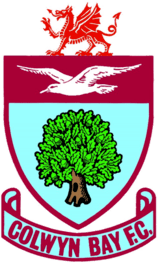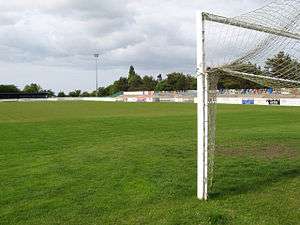Colwyn Bay F.C.
 | |||
| Full name | Colwyn Bay Football Club | ||
|---|---|---|---|
| Nickname(s) | 'Seagulls' or 'The Bay' | ||
| Founded | 1881 | ||
| Ground | Llanelian Road, Old Colwyn | ||
| Capacity | 3,000 (500 seated)[1] | ||
| Chairman | William Murray | ||
| Manager | Craig Hogg | ||
| League | Northern Premier League Division One West | ||
| 2017–18 | Northern Premier League Division One North, 9th of 22 | ||
| Website | Club website | ||
|
| |||
Colwyn Bay Football Club (Welsh: Clwb Pel-Droed Bae Colwyn) is a football club based in Old Colwyn in north Wales. Despite being a Welsh club, they currently play in the English leagues and are members of the Northern Premier League Division One West. Nicknamed the Seagulls, but also known as 'The Bay', their home ground is Llanelian Road in Old Colwyn.
History
The club played its first match in January 1881 and joined the North Wales Coast League in 1898.[2] The club were forced to resign from the league during the 1900–01 when they could not find a home ground to play at,[3] with their fixtures taken over by Penmaenmawr Royal Welch Fusiliers.[4] However, they returned to the league the following season.[5] From 1907, the club became known as Colwyn Bay United.[6] After the league folded in 1921, they joined the Welsh National League. In 1927–28 the club finished as runners-up in the league and won the League Cup. They won the cup for a second time in 1929–30,[7] also reaching the semi-finals of the Welsh Cup, in which they lost 3–1 to Rhyl Athletic.[8] The league folded at the end of the season and the club were subsequently founder members of the North Wales Football Combination, which they went on to win in its first season.[9] Following their title, the club joined the Birmingham & District League.[7] However, the team struggled in the new league, and after finishing bottom in 1935–36 and 1936–37,[10] they switched to the Welsh League (North).[7]
Colwyn Bay finished as Welsh League (North) runners-up in 1945–46,[11] the first season after World War II. They were runners-up again in 1963–64,[12] and were champions the following season.[13] The early 1980s saw the club enter a period of success, as they were champions for a second time in 1980–81.[14] In 1982–83 the club won the league and reached the Welsh Cup semi-finals, losing 4–0 on aggregate to Swansea City.[8] After retaining the league title in 1983–84,[7] the club returned to the English football league system, joining Division Three of the North West Counties League. They finished as runners-up in their first season in the league and were promoted to Division Two.[8] A fourth-place finish in Division Two 1986–87 saw the club promoted to Division One.[8] In 1987–88 the club reached the first round of the FA Cup for the first time, losing 1–0 at Northwich Victoria.[8] The following season saw the club win the League Cup, beating Warrington Town 3–0 in the final at Gigg Lane.[7] After finishing as Premier Division runners-up in 1990–91, they were promoted to Division One of the Northern Premier League, filling the vacancy created by South Liverpool folding.[7] They won the division at the first attempt and were promoted to the Premier Division.[8] The season also saw them win the North Wales Coast Challenge Cup and reach the Welsh Cup semi-finals for a third time, losing 4–2 to Hednesford Town.[8]
However, at the end of the 1991–92 season, a dispute with the Football Association of Wales led to Colwyn Bay being ordered to join the League of Wales or cease playing in Wales. As a result, the club started the new season playing at the Drill Field in Northwich, before moving to Ellesmere Port Stadium in Ellesmere Port. A court injunction allowed the club to return to playing home matches in Colwyn Bay in 1994 before the case was won in the High Court of Justice in April 1995.[7] In 1995–96 they reached the first round of the FA Cup again; after beating Spennymoor United 1–0 in the first round, they lost 2–0 at Blackpool in the second round.[8] They qualified for the first round again the following season, eventually losing 2–0 to fellow north Wales club Wrexham in a replay.[8] Another first round appearance in 1997–98 resulted in a 2–0 defeat at Notts County.[8] The club remained in the Northern Premier League's Premier Division until the end of the 2002–03 season, when they were relegated to Division One. In 2006–07 a fifth-place finish saw the club qualify for the promotion play-offs, in which they lost 3–2 to Cammell Laird in the semi-finals.[15] League restructuring led to the club being placed in Division One South for the 2007–08 season, before being switched to the North division the following season. Their first season in Division One North resulted in a fourth-place finish and another play-off campaign, in which they lost their semi-final match 4–2 on penalties to Newcastle Blue Star after a 2–2 draw.[8] However, after finishing fourth again in 2009–10, the club were promoted back to the Premier Division via the play-offs, beating Curzon Ashton 2–1 in the semi-finals and then winning 1–0 against Lancaster City in the final.[8]
The 2010–11 season saw Colwyn Bay finish as Premier Division runners-up. In the subsequent play-offs they beat North Ferriby United 2–1 in the semi-finals and then defeated FC United 1–0 in the final to earn promotion to the Conference North.[8] After four seasons in the Conference North, the club were relegated back to the Northern Premier League's Premier Division at the end of the 2014–15 season. They were relegated again in 2015–16, returning to Division One North.[8]
Ground

The club played at Eirias Stadium until 1984, when they moved to their current Llanelian Road ground.[7] The Shed End stand was erected in 1985 and two more stands built by 1990, when floodlights were installed and inaugurated with a friendly match against Liverpool. When the club was forced to play outside Wales in 1992, they initially played at Northwich Victoria's Drill Field, before moving to Ellesmere Port.[7]
After returning to Llanelian Road in 1994, terracing was installed on the Llanelian Road side of the ground in 1998. Following promotion to the Conference North, a new 500-seat stand was built during the 2011–12 season.[7] The ground currently has a capacity of 3,000, of which 500 is seated.[1]
Management team
| Position | Name |
|---|---|
| Manager | Craig Hogg |
| Assistant Manager | Neil Coverley |
| Academy Director | Chris Thompson |
| Physio | Lisa Edwards |
| Kit manager | Bryan Kelly |
Honours
- Northern Premier League
- Division One champions 1991–92
- North West Counties League
- League Cup winners 1988–89
- Welsh League (North)
- Champions 1964–65, 1980–81, 1982–83, 1983–84
- North Wales Football Combination
- Champions 1930–31
- Welsh National League
- League Cup winners 1927–28
- North Wales Coast Challenge Cup
- Winners 1991–92
Records
- Best FA Cup performance: Second round, 1995–96[8]
- Best Welsh Cup performance: Semi-finals: 1929–30, 1982–83, 1991–92[8]
- Best FA Trophy performance: Quarter-finals, 1996–97[8]
- Record attendance: 5,000 vs Borough United, 1964 (at Eirias Park)[16]
- Most appearances: Bryn Jones[16]
- Most goals: Peter Donnelly[16]
See also
- Colwyn Bay F.C. players
- Colwyn Bay F.C. managers
References
- 1 2 Colwyn Bay Northern Premier League
- ↑ North Wales Coast League tables 1898-99 Welsh Football Data Archive
- ↑ North Wales Coast League Welsh Football Data Archive
- ↑ North Wales Coast League tables 1900-01 Welsh Football Data Archive
- ↑ North Wales Coast League tables 1901-02 Welsh Football Data Archive
- ↑ North Wales Coast League tables 1907-08 Welsh Football Data Archive
- 1 2 3 4 5 6 7 8 9 10 A brief history Colwyn Bay F.C.
- 1 2 3 4 5 6 7 8 9 10 11 12 13 14 15 16 17 Colwyn Bay at the Football Club History Database
- ↑ North Wales Football Combination 1930-31 Welsh Football Data Archive
- ↑ Birmingham & District League 1930-1962 Non-League Matters
- ↑ Welsh League (North) 1945-46 Welsh Football Data Archive
- ↑ Welsh League (North) 1963-64 Welsh Football Data Archive
- ↑ Welsh League (North) 1964-65 Welsh Football Data Archive
- ↑ Welsh League (North) 1980-81 Welsh Football Data Archive
- ↑ 2006-07 Northern Premier League Football Club History Database
- 1 2 3 Mike Williams & Tony Williams (2012) Non-League Club Directory 2013, p189 ISBN 978-1-869833-77-0
External links
Coordinates: 53°16′56.16″N 3°41′58.70″W / 53.2822667°N 3.6996389°W